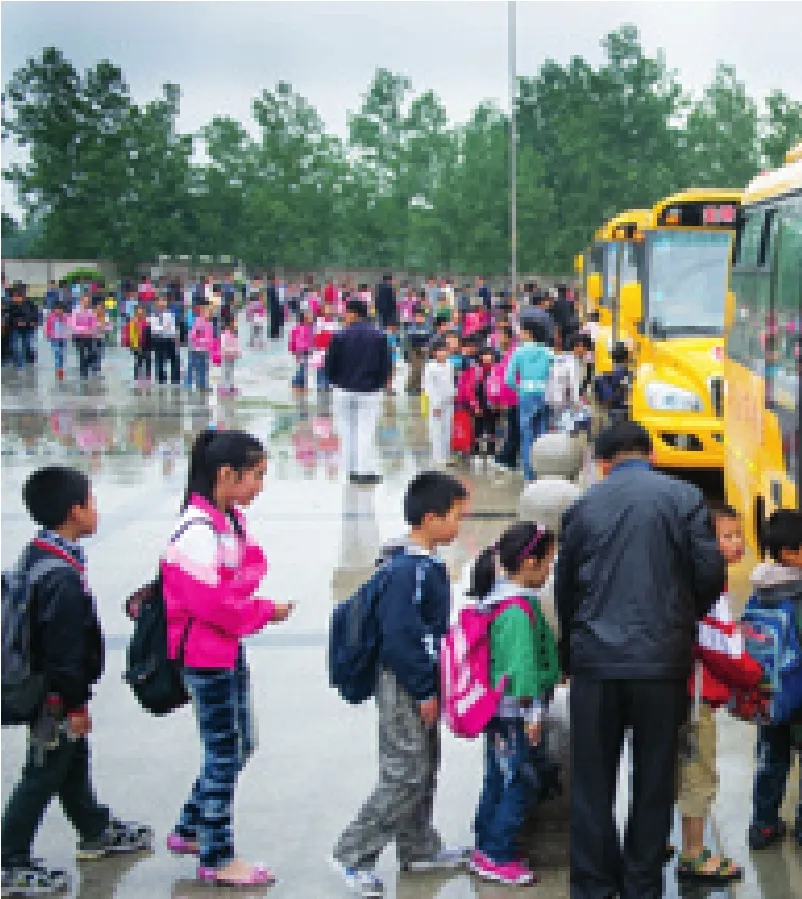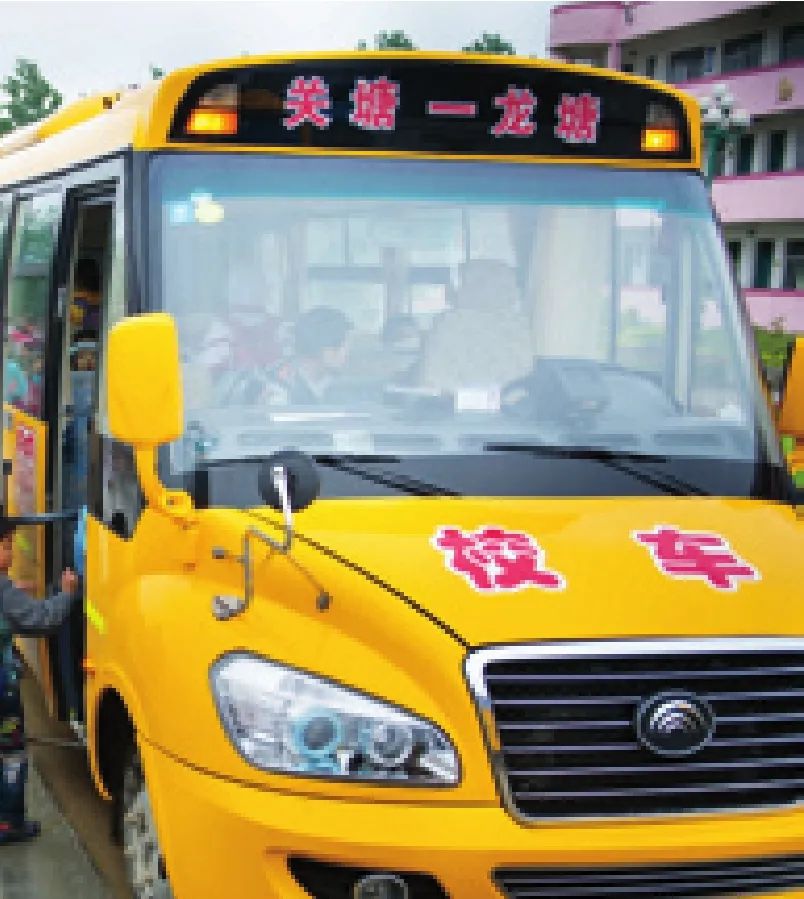Reviving Education In the Countryside
2013-12-07ByYinpumin
By Yin pumin
Breathing new life into rural schools
The Rongsheng Hope Primary School has witnessed a sharp drop in enrollment,declining from 180 students to only 30 in just three short years.
Once upon a time, this school in a remote village in northwest China’s Gansu Province catered to children up to grade six, but today there are only first and second grades. The other four merged into a larger township primary school.
Since 2001, dropout rates have risen as rural school districts have been indiscriminately re-zoned and amalgamated into mass institutions. According to a National Audit Office (NAO)survey of 1,155 schools in 52 major counties released on May 3, the number of dropouts more than doubled to 8,352 in 2011 from 3,963 in 2006. From May to August last year, the NAO carried out random surveys of more than 25,000 schools in more than 1,200 counties across the country.
The surveys also revealed that unscrupulous merging has greatly reduced the total number of rural primary schools and forced a number of children to walk longer distances to and from places of learning.
About 4 percent of the 12.6 million nonresident students have to travel more than 6 km per day on foot or spend more on transport to get to school, according to a NAO report.More than 100,000 rural children, mainly in mountainous areas, have to walk more than 10 km, adds the report.

SCHOOL BOAT:Children in Maoshe village in Wuning County, Jiangxi Province, board a boat to school on May 17
Increasing dropouts


STAYING ON: Lai Feng,a 75-year-old teacher,holds class at Guanbu Primary School in Anyuan County, east China’s Jiangxi Province,on May 18, 2012
Early in November last year, a report issued by the Beijing-based 21st Century Education Research Institute (CERI) claims that the primary school drop-out rate had rebounded to levels similar to those seen in the late 1990s, claiming that merging rural schools has caused students to drop out.
An average of 63 primary schools, 30 learning centers and three middle schools vanished each day in rural areas between 2000 and 2010, according to the CERI report. Each hour,four rural schools disappeared.

SAFE JOURNEY: Children board school buses at Guantang Primary School in Tianchang, east China’s Anhui Province, on May 16
In the first decade of the century, the number of rural primary schools decreased by 229,000, or 52 percent. During the same period, 10,600 middle schools closed.
Rural schools have been disappearing since 2001, when a central government policy set out to consolidate educational resources in counties and townships amid rapid urbanization and dwindling rural populations.
In the same year, the merging of rural schools was listed as a priority to develop rural compulsory education. Since then, the program of closing and merging schools has been carried out across the country.
For example, in Butuo County in Liangshan Yi Autonomous Prefecture in Sichuan Province,the number of rural primary schools has dropped to 10 percent of the total number of the county’s primary schools, down from more than 30 percent a decade ago.
“Back in 2003, primary schools were available in all 190 villages in the county, but now only 58 such schools are left,” said Rong Jinglong, an official at the Butuo County Bureau of Education.
“Closing down some of these rural schools was the right thing to do considering the circumstances back then,” said Fan Xianzuo, a professor at Central China Normal University in Wuhan, Hubei Province. “But in many places proper procedures were not followed, bringing severe consequences.”
In the past decade or so, the number of students registered in rural primary schools decreased by more than 31.5 million, or 37.8 percent, according to the CERI report. The number of middle schools plummeted by 16.4 million, or 27 percent.
“Some of them have shifted to township or county schools but many of them simply dropped out,” said Yang Dongping, Director of the CERI.
According to Han Qinglin, Chairman of the Association of Rural Education under the Chinese Society of Education, the dropout rate of rural primary school students rose to 8.8 out of 1,000 in 2011, almost the same level as in 1997.
“The continuous merging of rural primary schools has resulted in not only the dropout of lower grade students, but even worse, a great deal of students cannot enter school,” said Han. “It is possible that the illiterate population may swell by more than 1 million every year.”
Experts say schools closed at a faster rate than the declining population of rural children. Liu Shanhuai, a researcher with the Rural Education Institute of Northeast Normal University, said that the cumulative decline in the number of rural children was around 3-4 percent from 2001 to now, whereas the rate of school closures stood above 6 percent.
The fact is that the closed schools were mainly located in small villages, where inconvenient transportation had a large impact on attendance.
“It is too hard for young students to walk a long way to a school and they are not capable of handling the dangers on the road either,” Liu said. “So once the nearby schools are closed,and there is no transportation or chance of accommodation at a distant school, their parents prefer to let them drop out.”
The NAO found that rural middle schools have to serve areas more than 8 km from their gates on average, compared with over 4 km for primary schools. But in China’s western regions, the average serving radius of middle schools exceeds 14 km and for primary school it’s 6 km.
Lasting impacts
The authorities have realized the shortcomings of blindly closing or merging rural schools. At a press conference on February 26, Du Kewei,an official on elementary education from the Ministry of Education (MOE), said that school mergers have stopped in many places, including the provinces of Henan, Anhui and Jiangxi,as well as Xinjiang Uygur and Ningxia Hui autonomous regions.
According to the MOE, local governments should work out feasible plans for the locations of their primary and middle schools in accordance with local conditions. Plans must be submitted to the Central Government department in charge of educational system reform before June. No closures or mergers are allowed until a new plan comes out, the MOE said.
Last September, the State Council, China’s cabinet, called on local governments to reopen closed schools or learning centers if necessary.“It is a positive signal and shows the government’s determination to solve emerging problems,” said Yuan Guilin, a professor of rural education at Beijing Normal University.
However, Tu Yanguo, Director of the College of Education of Central China Normal University, expressed his concerns for the future of China’s rural education. “Although the MOE has halted the mergers, their effects are still creating problems for local education authorities and schools,” Tu said. He said that excessive mergers have had a negative effect on teaching quality, school safety and accommodations for students.
The removal of village primary schools has led to overcrowding. In Butuo County’s Ethnic Primary School, the admissions quota is set at less than 1,200, yet their current student body numbers 1,800.Meanwhile, a survey conducted in 2008 by the education authorities of Shaoyang County in central China’s Hunan Province showed that the average number of students per class in local primary, middle and high schools was 63,which was above the provincial standard.Four classes in Shaoyang No.1 Middle School even exceeded 100 students.
Even if township schools are large enough,most of them are located far away from villages and very few offer bus services. According to the NAO, over 1,700 schools offered bus services, only 6.77 percent of those surveyed.More than 412,000 students are forced to hire rides independently without proper oversight,the NAO report showed.
Concerned about safety, more and more parents prefer their offspring attend boarding school or move closer to towns. But boarding school dorms can only meet 84 percent of demand for 5.54 million students who apply for such accommodation, the NAO report says.
“It’s a good thing to gather rural students together to attend middle school in townships,for better education,” said Han with the Chinese Education Society. “But for young children, this is not such a good idea since they need to be taken care of.
“In addition, the expenses of rent and transportation will be a large burden for most rural families,” he added.
Under such pressure, many rural children have chosen to abandon their rights to education and just drop out, Han said, adding that the trend will further worsen the rising disparity in rural and urban education.
Addressing inequality
For a long time, the rural-urban education gap has been a headache for China. The government has done a great deal to close the gap, from providing nine years of free education for all rural students starting from 2006,to the annual input of 16 billion yuan ($2.57 billion) in a 2011 program to provide 26 million rural students with free lunches.
China currently exempts students in both urban and rural areas from school fees during the compulsory education period, provides free textbooks for students from needy families and offers living allowances to underprivileged students from rural areas. China’s nine-year compulsory education program typically consists of six years of primary school and three years of middle school.
Meanwhile, according to a statement released by the Ministry of Finance (MOF) on May 8, public expenditure on education in China reached 2.2 trillion yuan ($353 billion) in 2012,accounting for 4 percent of the national GDP.
China is shifting its growth pattern by enhancing education, with more resources allocated to rural, remote and poor schools last year, the MOF said. In 2012, the country earmarked 86.5 billion yuan ($13.9 billion) from its central budget to support rural compulsory education. The government has also provided allowances for more than 13 million students who came from poor families and attended boarding schools in central and western regions.
Despite the encouraging achievements,some areas leave much to be desired, such as in bridging the gap between the quality of education in urban and rural areas, and between key schools and ordinary schools, said Minister of Education Yuan Guiren.
“The free nine-year compulsory education only ensures that every child can receive an education. We see some people paying extra fees for their children to be admitted to key schools, which results from the disparity of educational quality in different areas,”Yuan said.
According to Yuan, due to imbalanced economic development and uneven distribution of educational resources, students in developed regions have better chances of attending college than students from poorer regions.
Since the 1990s, the proportion of rural students in China’s universities has been dropping steadily. The percentage at Peking University had fallen from 30 percent to 10 percent, while at Tsinghua University rural students made up only 17 percent of the student body in spite of accounting for 62 percent of entrance exam takers, according to research by the two universities in 2011.
Peking University surveyed Beijing,Shanghai and Guangdong Province in 2009, revealing that only 0.7 percent of the 2,732 rural respondents had university degrees or higher,as opposed to 13.6 percent among the 3,253 urbanites polled.
Chu Zhaohui, a senior researcher at the National Institute of Education Sciences, also acknowledged the low proportion of rural students attending top universities in recent years.
“This unfair situation is partly rooted in the massive differences in basic education between rural and urban areas,” Chu claimed.
For instance, he suggests the government increase teaching salaries, because good teachers in rural areas are few and far between.
In 2009, Wang Pengwei and Si Xiaohong,professors at Shaanxi Normal University, conducted a survey among over 360,000 teachers at primary and middle schools in the province and found that only 42 percent of teachers in rural areas held a bachelor’s degree, while the proportion for urban teachers was closer to 74 percent.
At the February 26 MOE press conference, Xu Tao, an official in charge of teacher management, said that 90 percent of teachers assigned to underdeveloped rural areas have chosen to keep their posts after the expiration of their contracts. Xu said the Central Government has raised the teachers’salaries and allowed them to pursue master’s degrees while working.
During a tour of southwest China’s Yunnan and Guizhou provinces in late March,vice Premier Liu Yandong stressed the role of rural education, which she said should serve as “a solid foundation for the growth of millions of rural children.” Liu said that the construction of boarding schools should be strengthened and weak schools should be assisted to improve teaching levels. Rural teachers’ training should be strengthened and their salaries and subsidies should be increased so that more outstanding teachers will be willing to continue working in the countryside, the vice premier said.
On May 15, the State Council released a statement promising the government will offer more opportunities for higher education to hard-working students in rural areas.
Last April, the MOE announced that 10,000 seats in prestigious universities would be reserved for students from leastdeveloped areas in the five years from 2012.The government decided to increase the quota to 30,000 this year. The additional students would mostly come from central and western regions, where colleges are scarce and competition for placement is fierce, according to the statement.
Li Chang’an, a professor on public policy at the Beijing-based University of International Business and Economics, said that long-term effort on access to education is needed.
“One day, when the country can fairly distribute educational resources among all students and regions, equality in education will be easier to achieve.” ■
